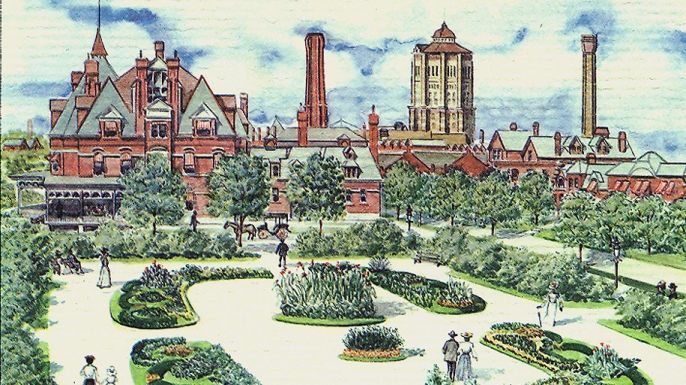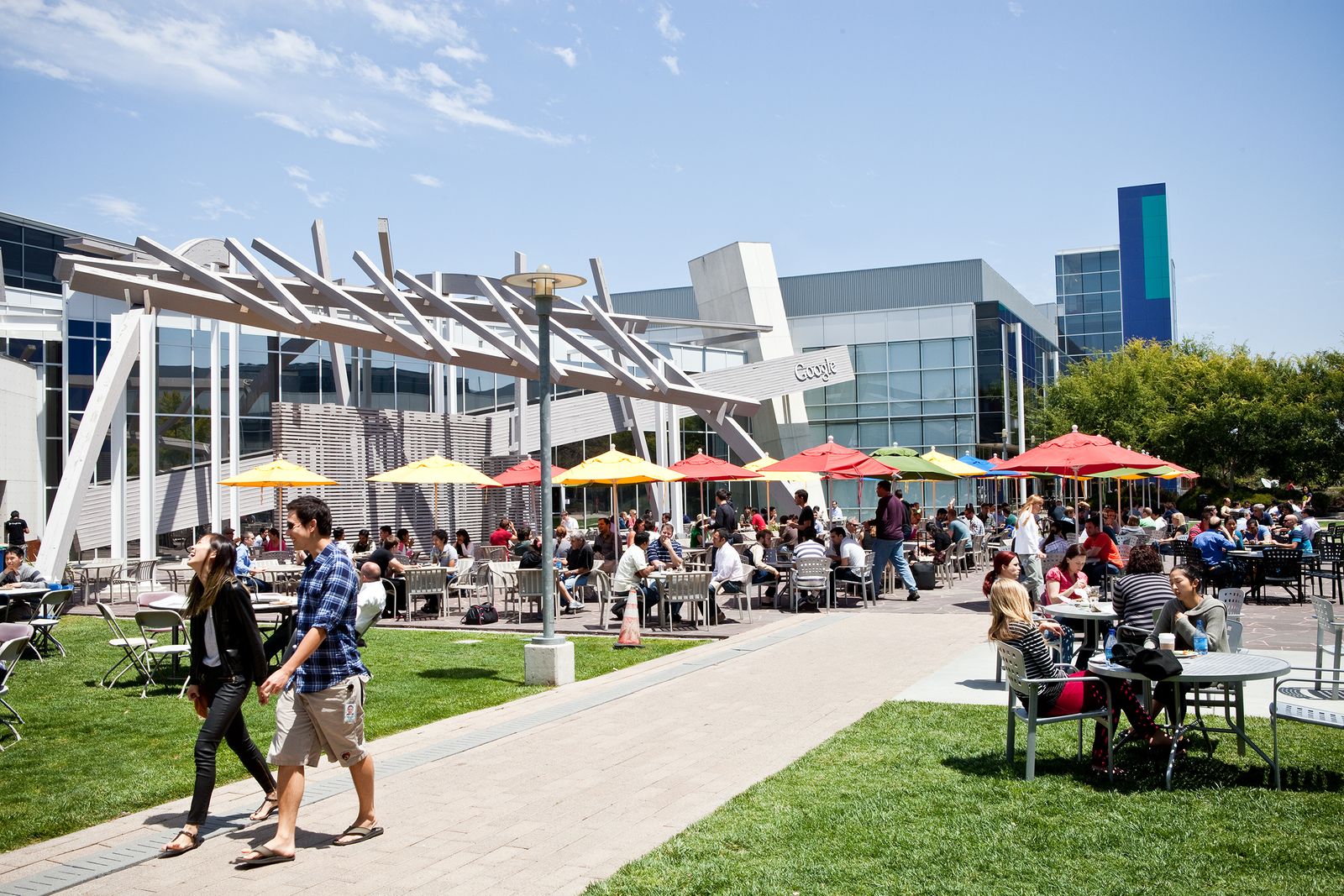The Death and Life of American Company Towns
June 29th, 2016
Google feeds its employees well. No Googler's desk is further than 150 feet from a "micro kitchen" stocked with goodies, and the campus is dotted with over 20 restaurants and cafes. Everything on the menu is free of charge to Googlers and their guests, and it includes specialities like creme brûlée and fresh handmade sushi.
The perks of working at Google extend far beyond the free food and snacks. Google HQ contains a bowling alley, bocce ball courts, sand volleyball, and infinite swimming pools. Showers at the fitness center provide towels to employees, allowing them to freshen up after a midday workout. Googlers can conveniently complete their personal chores at the on-campus hairdresser, mechanic, medical clinic, and laundromat, and they can relax and think through work challenges with a long massage.
  |   |
Google also ensures that employees' families are well-cared for. The company subsidizes daycare and offers 22 weeks of paid maternity leave to new mothers. If an employee dies, his stocks are fully vested at once and the spouse receive half of his salary for the next 10 years.
Tech companies are famous for their incredible employee benefits. Workers in other industries talk longingly about the wifi-outfitted work shuttles, catered meals, and dog-friendly offices. While these benefits appear uniquely generous, they descend from a long history of corporate paternalism with roots in Industrial Revolution-era company towns. These towns served the same fundamental purpose as Google's generous benefits today—to attract, retain, and shape loyal employees.
Origins
The earliest company towns were constructed out of necessity. Extraction industries such as logging and mining were naturally found in remote locations in Appalachia or further west, far from the reaches of urbanization. The automobile was rare among the working class, and train routes rarely catered to passengers. "It would have been impractical for men to commute, even on weekends," wrote James Allen in his book The Company Town in the American West.
These early company towns resembled refugee camps, comprising rows of tents with no running water or electricity. Workers were attracted to these jobs for their high wages rather than the living conditions. However, the men soon discovered that their cost of living was even higher. Prices at the company store reflected the costly long-distance travel to these working camps, and employers abused their monopoly as the only shop in town to inflate the prices further. Workers' high wages flowed back into the pockets of the corporation that paid them. These early towns functioned to basically enslave employees, tying them to their debts at the company store.
However, it became difficult for employers to maintain the imbalance of this relationship. The vast distances from company towns to the rest of civilization quickly shrank as America steadily moved west, workers' unions strengthened, and urban factories became the dominant employers. Company towns evolved in these changing conditions rather than disappearing. While these towns had previously served to house and extort workers, they became a tool to attract and mold them.
Recruiting & retaining the best workers
Companies quickly found that generous benefits could attract and retain the most loyal and productive employees. In particular, employers sought family men over the rowdy bachelors who had populated earlier company towns. Married men were thought to be more stable, "less likely to carouse" because they would be more settled with the presence of a wife and children.
"The married ones tended to stay around. We lose money on the town," explained Stanwood Murphy, President of the Pacific Lumber Company. "We figure it's worth it though, to keep a good crew here."
The Endicott-Johnson Corporation, a New York-based shoe manufacturer, offered especially extensive benefits (as I’ve written about before). Famously, rides on the many carousels in Johnson City were free to all. Its "Square Deal" program included comprehensive healthcare, affordable housing, swimming pools, theaters, and golf courses. To factory workers in the early 1900s, Johnson City was utopia. This was particularly attractive to immigrants, as company towns immediately gave workers a home and credit at the company store.
Workers flocked to EJ's shoe factories, and the company was consistently profitable despite providing the highest wages in the industry. The EJ brand of welfare capitalism fostered an intense devotion to the company and offered security even in harsh economic times. However, the Square Deal had implications beyond the employee's working and living conditions. Daily life was structured around factory hours and the demands of the market. It implicitly demanded absolute loyalty from workers, and it discouraged unionizing in a time when conflict between labor and industry was at its height.
Molding the perfect employee
Corporations soon found another benefit to building company towns around their factories rather than sourcing labor from already densely-populated cities: they were eager to keep workers away from radicalizing elements in cities.
"The anarchists and socialists were ... continually breeding discontent among our workmen and inciting them to strike," said piano manufacturer William Steinway.
Acting as both landlord and employer gave corporations the ability to evict anyone who went on strike and to manage their day-to-day lives. Constructing their own utopias enabled employers to control as well as attract the perfect employee.
Perhaps the most infamous company town of the Industrial Revolution was Pullman, Illinois which was built by train car manufacturer George Pullman in 1884. That era marked the initiation of the American labor movement, characterized by a series of violent strikes. Pullman envisioned his company town as a place where there would be no need for a strike and built what he called a "model community" in hopes of suppressing any labor unrest. The result was 1,000 residences with yards, daily trash removal, indoor plumbing, and gas, rare amenities for industrial workers of that era.

Generous corporations like Pullman and EJ did fare better than most during this period of increasingly organized labor. However, they were not entirely spared their employees' grievances. Living conditions in Pullman were far better than the industry standard, but the employees' idyllic lives were extremely restricted. Alcohol was prohibited within the town limits, except at the fancy Hotel Florence which was strictly off-limits to factory workers. Every photo of the town's beautiful parks and rolling lawns from that era is empty of people, because public gatherings had to receive explicit permission from the corporation.
Resentment for these policies boiled under the surface for years, and when the company slashed wages with no rent reduction in 1894, the workers revolted. The damages of the railcar strike extended so far across the nation that President Grover Cleveland ordered in the Army to stop the strikers from obstructing the trains. In the aftermath, a commission found George Pullman's paternalism partly to blame and annexed the town into greater Chicago. Cleveland also designated Labor Day as a federal holiday in an effort to appease organized labor after the strike.
George F. Johnson, the shoe manufacturer that founded Endicott-Johnson, fared a bit better than the tyrannical head of the Pullman Company. The company faced threats of unionization for the first time at the end of the 1930s, half a century after the American labor movement began. Former worker Elmer Knowles remembered that George F. "went down and he parked his car in the parking lot and he tried to talk to us on the loudspeaker. And I'll never forget … he drove away in tears." When a vote was scheduled for the workers to make a choice of voting for or against unionizing, 80 percent of the workers voted against it, despite the hard times of the Great Depression. When George F. died in 1948, his funeral was held at the local stadium, packed with thousands of his former employees.
Where we are today
The American economic landscape has changed since George F.'s death, and the Endicott-Johnson Corporation has changed along with it. Over the decades, the company cut back more and more departments, until finally it was bought by U.S. Industries and its operations moved to Tennessee. Author of Workers, Managers, and Welfare Capitalism Gerald Zahavi said, "I don't think that workers expect very much from corporations today." The manufacturing industries that have dominated the American economic landscape for generations are laying off thousands of blue collar workers and outsourcing their jobs overseas rather than competing over their loyalty.

In this landscape, the Googles of the world seem too good to be true. However, they are operating under very different circumstances than modern manufacturers. While it makes little sense for the average US employer to invest in company towns and other employee benefits and levers of control, the demand for technical talent in the Bay Area continues to skyrocket. SmartRecruiters expects that computer science-related job openings are expected to grow more than 33 percent by 2020, and salaries reflect that immense demand for these high-skill workers.
These tech companies have simply learned lessons from history. Companies like Google have learned that a secret to playing the competitive recruitment field is to leverage their strength in numbers and logistical talent to offer qualitative benefits beyond just salary to their workers. Onlookers have applauded Google's lavish treatment of its workers, and for good reason. However, it is naive to look at these choices simply as the result of generosity—a quick look at history tells us that well-executed corporate paternalism is also good for the bottom line.
Keep in touch!